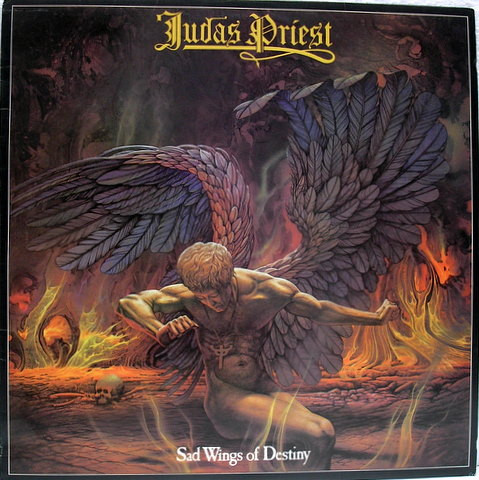„Prelude“, the instrumental piece from Judas Priest’s 1976 album Sad Wings of Destiny, serves as an ominous and dramatic introduction to „Tyrant“, setting the tone for the impending chaos. Unlike the raw aggression and soaring vocals of the album’s other tracks, Prelude relies on classical-inspired piano melodies, haunting atmosphere, and slow-building tension to create a sense of impending doom.
Though it contains no lyrics, its composition and structure tell a story of power, control, and fate—leading seamlessly into the explosive force of „Tyrant“.
Overview
At its core, Prelude conveys:
- A sense of tragic grandeur, evoking medieval or apocalyptic imagery.
- A feeling of inevitability, as if leading into something monumental and catastrophic.
- A classical influence, reinforcing themes of destiny, power, and impending war.
- A seamless transition into „Tyrant,“ suggesting that the ruler’s arrival is both majestic and terrifying.
Rather than being a standalone track, Prelude acts as the calm before the storm, preparing the listener for the album’s descent into power struggles and rebellion.
Narrative Structure & Themes
1. The Opening (Majestic Yet Foreboding)
- The song begins with grand, almost regal piano melodies, setting a mood that is both sorrowful and powerful.
- The classical influence gives it a feeling of medieval court music, possibly evoking a kingdom on the brink of war or a ruler preparing for battle.
- The slow tempo and solemn tone create a false sense of security, luring the listener into an atmosphere of order and tradition—before it all collapses in „Tyrant.“
- Themes: Majesty, impending fate, tragic beauty.
2. The Rising Tension (Building Toward Conflict)
- As the melody progresses, it begins to feel more urgent, more foreboding.
- The classical-style piano lines, reminiscent of baroque compositions, suggest grandeur but also oppression—as if something dark is lurking beneath the surface.
- The tension builds, hinting that something is about to break—whether it’s a kingdom, a ruler, or a rebellion.
- Themes: Growing unrest, inevitability, prelude to destruction.
3. The Seamless Transition (Prelude to Tyranny)
- Prelude does not end in a conventional way—it flows directly into „Tyrant“, where the full force of Judas Priest’s heavy metal sound explodes.
- This suggests that the peace and order hinted at in Prelude were always a façade—leading to the violent reality of war, domination, and the rule of the „Tyrant.“
- The contrast between the delicate piano of Prelude and the crushing riffs of Tyrant serves as a perfect musical representation of a kingdom falling into chaos.
- Themes: The rise of the oppressor, the fall of peace, the dawn of war.
Themes & Symbolism
1. The Calm Before the Storm
- Prelude represents the deceptive peace before tyranny takes hold.
- This follows a classic storytelling pattern—where tranquility is shattered by overwhelming power.
- It mirrors historical cycles of rulers rising and empires falling, a key theme in Sad Wings of Destiny.
2. Classical vs. Heavy Metal (Symbolizing Power & Fate)
- The classical influence in Prelude evokes the dignity and order of an empire, while Tyrant represents the violent reality of dictatorship.
- This musical contrast reflects themes of fate, power struggles, and oppression.
3. The March of Destiny
- The slow, grand piano movement could symbolize a ruler’s inevitable rise to power or the last moments of freedom before tyranny takes hold.
- It gives the impression of a prologue to something much greater and more terrible.
Musical & Emotional Impact
1. Haunting Piano Melody (Elegance & Doom)
- The classically inspired piano work sets a somber yet majestic mood.
- It feels almost like a funeral march, hinting at the downfall of something once great.
2. Lack of Vocals (A Wordless Prophecy)
- The absence of lyrics allows the music to speak for itself, making it feel like an instrumental prophecy of what’s to come.
- The transition into Tyrant suggests that words are no longer needed—action is about to take place.
3. The Transition to Tyranny (Explosion into Metal)
- The final moments of Prelude feel like they are on the verge of collapse, before Judas Priest fully unleashes their power in Tyrant.
- This shift heightens the drama, making Prelude not just an intro, but a critical piece of the album’s storytelling.
Legacy & Influence
- One of Judas Priest’s earliest uses of classical elements, influencing future symphonic and progressive metal bands.
- A prime example of how instrumental tracks can enhance narrative structure in metal albums.
- Reinforced the use of classical composition in heavy metal, a technique later perfected by bands like Yngwie Malmsteen, Rhapsody of Fire, and Symphony X.
- A precursor to metal’s fascination with themes of fate, power, and downfall.
Final Verdict
„Prelude“ may be short and instrumental, but its role in Sad Wings of Destiny is crucial. It sets the stage for tyranny, deception, and rebellion, creating a grand yet tragic atmosphere that makes the album’s heavier moments even more impactful.
A masterful example of how Judas Priest blended classical grandeur with heavy metal power—making Prelude one of the most haunting introductions in metal history.



